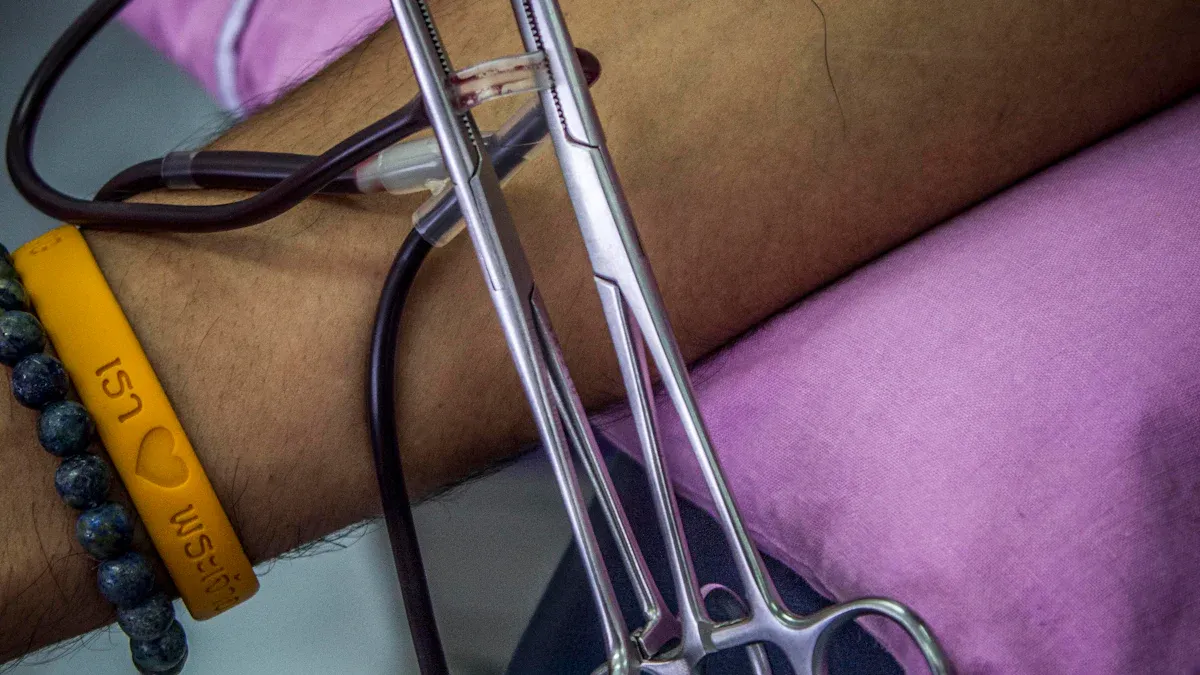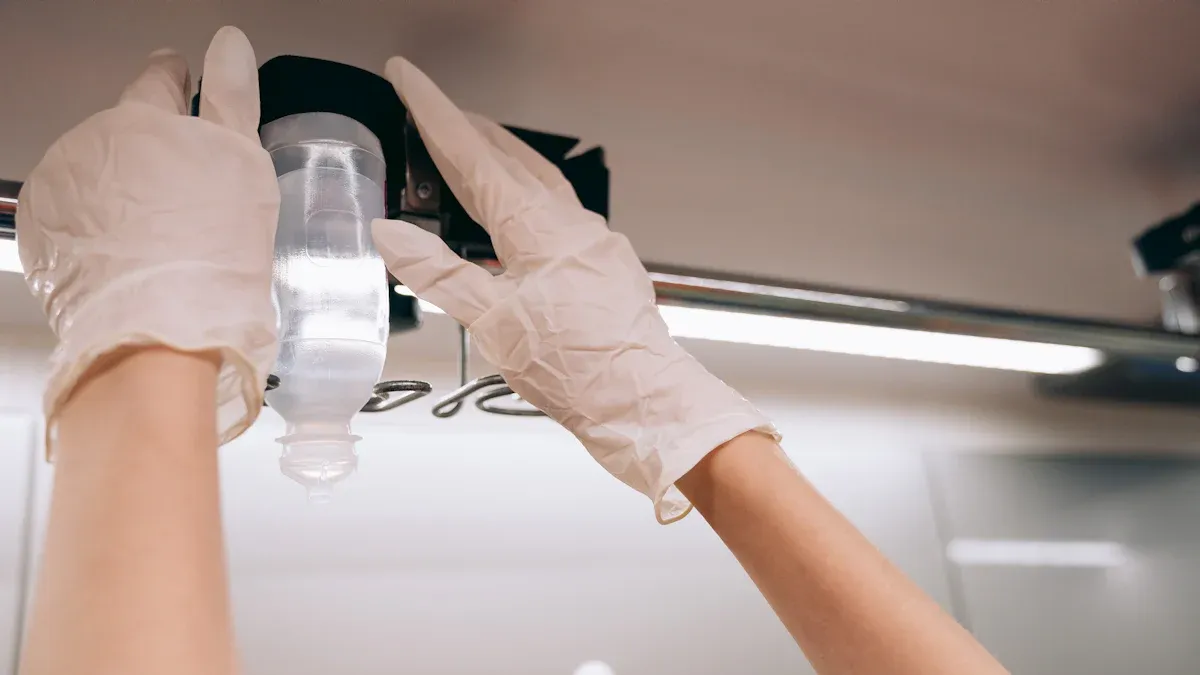Step-by-Step Guide to Picking the Ideal PKP Balloon Catheter

Picking the right catheter for procedures like PKP is important. The best PKP balloon catheter helps fix spine height and lowers risks. For instance, studies show cement leaks drop from 40% in vertebroplasty to 10.7% in PKP. This happens because the balloon presses on nearby bone, stopping leaks. Choosing the right catheter improves patient safety and healing.
AccuPath also provides custom-made PKP balloon catheters with top quality for your needs.
Key Takeaways
Picking the right PKP balloon catheter keeps patients safer in surgery.
Know the surgery goals and patient needs to choose the best catheter.
Check the catheter's strength and inflation control to avoid problems like leaks.
Work with your team to share ideas and ensure the catheter works with your tools.
AccuPath makes custom PKP balloon catheters to improve safety and results.
Understanding PKP Balloon Catheters

What Are PKP Balloon Catheters?
PKP balloon catheters are tools used in spine surgeries like PKP. These catheters have a balloon that can inflate inside bones. The balloon helps fix crushed bones by creating space for cement. This makes the bone stable and reduces pain. They are used to treat broken spine bones caused by weak bones, injuries, or tumors.
Knowing how these catheters work is very important. It keeps patients safe and helps them heal better. Learning about their features helps doctors pick the right one. This improves treatments and makes patients feel better.
Applications of Balloon Catheters in Medical Procedures
Fixing Spine Height
Balloon catheters help fix the height of crushed bones. When the balloon inflates, it lifts the bone back up. This helps fix posture and reduces pressure on nearby tissues.
Easing Pain from Broken Bones
These catheters make broken bones stable, which eases pain. Many patients feel better right after the procedure. This makes these tools very helpful for spine injuries.
Key Features of PKP Balloon Catheters
Strong Materials
The material of the catheter decides how strong it is. Good materials make sure the balloon can handle the pressure. Strong catheters are safer and less likely to break.
Balloon Inflation and Control
How the balloon inflates is also important. Advanced catheters let doctors control the size of the balloon. This prevents problems like cement leaks or tissue damage.
AccuPath offers custom PKP balloon catheters made with high quality. These can be adjusted to fit your needs.
Types of PKP Balloon Catheters

Single-Lumen vs. Double-Lumen Catheters
Design Differences
Single-lumen catheters have one channel for delivering fluids. Double-lumen catheters have two channels for different substances. This makes double-lumen catheters more flexible but harder to use.
Specific Use Cases
Single-lumen catheters work best for simple procedures needing one fluid. They are easy to insert and have a lower infection risk.
Double-lumen catheters are used for complex treatments needing multiple fluids. These are common in intensive care or advanced medical cases.
Tip: Single-lumen catheters are popular because they are simple and affordable. By 2025, they may hold 33.4% of the market share.
High-Pressure vs. Low-Pressure Balloon Catheters
When to Use High-Pressure Catheters
High-pressure catheters are used when strong force is needed. They help fix severe bone problems or restore bone height. Studies like ISAR-CALC show they work well in tough cases.
Benefits of Low-Pressure Catheters
Low-pressure catheters are safer for weak or fragile bones. They lower risks like balloon bursts or cement leaks. These catheters are easier to control and good for delicate fractures.
Specialty Catheters for Complex Cases
Catheters for Osteoporotic Bone
Special catheters for weak bones are safer and more precise. They are made to avoid fractures during use, helping patients with low bone strength.
Catheters for Tumor-Related Fractures
Tumor-related fractures need special catheters for uneven bone shapes. These catheters give better support and stability. Multi-lumen designs help deliver medications during the procedure.
Note: AccuPath makes custom PKP balloon catheters to fit your needs.
Guiding Catheter Selection: A Step-by-Step Approach
Step 1: Understand the Procedure
Know the Procedure Goals
Start by figuring out what the procedure needs to achieve. Are you fixing bone height, stabilizing fractures, or easing pain? Different goals need different PKP balloon catheters. For example, tough fractures may need high-pressure balloons. Fragile cases do better with low-pressure ones. Knowing the goal helps you pick the right catheter.
Choose the Right Balloon Size and Pressure
After setting the goals, think about the balloon's size and pressure. Big balloons are good for fixing large height issues. Small balloons work for tiny adjustments. Pressure is also important. High-pressure balloons are for strong bones, while low-pressure ones are safer for weak bones. Match the balloon to the procedure for the best results.
Step 2: Think About the Patient
Check Bone Strength and Condition
It's important to prepare based on the patient's bone health. Bone strength affects how well the catheter works. Older patients, especially those on certain medicines, have weaker bones. This makes them more likely to have fractures after surgery. Use catheters made for weak bones to keep them safe and avoid problems.
Consider Age and Health Issues
Age and health problems also matter when choosing a catheter. Older people often need special catheters for their fragile bones. Conditions like osteoporosis or cancer may need advanced catheters. Picking the right one for the patient’s needs leads to better results and fewer risks.
Step 3: Check Catheter Details
Look at Balloon Size and Length
Pay attention to the balloon's size and length. These affect how well it works. Bigger balloons help with serious fractures. Shorter ones are better for small bones. Make sure the catheter fits the patient’s body and the procedure’s needs.
Check Inflation and Pressure Limits
The balloon’s inflation and pressure limits are very important. The catheter must handle the needed inflation without breaking. Hospitals test these limits to make sure they are safe and reliable. This ensures the catheter works well and keeps the patient safe.
Note: AccuPath lets you customize PKP balloon catheters to fit your needs.
Step 4: Check Manufacturer Guidelines
Read Product Information
Before picking a PKP balloon catheter, read the product details. This helps you learn about its limits, uses, and features. Look at things like how much the balloon can inflate, how strong the material is, and if it works with your tools. Many companies give charts to compare their catheters. These charts make it easier to choose the right one for your procedure.
AccuPath lets you design custom PKP balloon catheters for special needs. Their guides explain how to prepare patients and use the catheter safely during treatments like PCI or other surgeries.
Compare Different Brands
Looking at different brands helps you find the best catheter. Check for differences in balloon size, how it inflates, and if it fits your tools. Some brands focus on strong balloons for tough fractures. Others make safer balloons for fragile bones. Think about how each brand handles patient safety and preparation.
Also, check reviews and feedback from other doctors. AccuPath’s catheters are trusted for being reliable and easy to adjust. Many surgeons prefer them for tricky procedures.
Step 5: Work with Your Team
Share Ideas and Experiences
Talk with your surgical team about their favorite catheters and past experiences. They might know which tools work best for certain procedures. Share tips on preparing patients and using catheters to get better results.
Team talks can also help spot problems like balloon breaks or cement leaks. Working together improves the process and keeps patients safe during treatments.
Make Sure Tools Work Together
Check that the catheter fits with your surgical tools. Look at inflation devices, guiding systems, and imaging machines to avoid delays. Matching tools makes the procedure smoother and safer.
AccuPath lets you design catheters that fit perfectly with your equipment. This makes surgeries safer and easier, which is why many doctors trust AccuPath for their needs.
Risks, Complications, and Contraindications
Possible Risks of Balloon Catheters
Balloon Bursting
A balloon bursting is rare but can happen in PKP. It may occur if the balloon is filled too much or if the bone is too weak to handle the pressure. Using strong materials and following instructions can help prevent this. AccuPath makes tough PKP balloon catheters that handle high pressure, lowering the chance of bursting.
Cement Leaks
Cement leaks are another possible problem. This happens when cement escapes into nearby areas, causing pain or other issues. PKP has fewer leaks compared to vertebroplasty. The balloon in PKP presses the bone together, reducing gaps and lowering leak risks. Picking the right catheter and watching the procedure closely can help avoid leaks.
Tip: Use catheters with good inflation control to prevent overfilling and keep patients safe.
Common Problems During Procedures
Infection Risks
Infections can happen if tools are not cleaned properly. These infections can lead to serious problems like abscesses or spreading germs. To stop this, make sure all tools, including the catheter, are clean before use. AccuPath offers high-quality PKP balloon catheters to support safer procedures.
Nerve Injuries
Nerve injuries can happen if the balloon or cement touches nearby nerves. This might cause pain, numbness, or trouble moving. Using imaging and placing the catheter carefully can help avoid this. Always work with your team to ensure the catheter is in the right spot.
When Not to Use PKP Balloon Catheters
Very Weak Bones
Patients with very weak bones may not be good for PKP. Fragile bones can break more during balloon inflation, causing more problems. Other treatments might be better for these patients.
Infections in the Area
If the area has an infection, using a catheter can make it worse. It might also spread the infection. Always check the patient’s health before starting the procedure.
Contraindication | Description |
|---|---|
Severe allergies | Patients allergic to materials like latex should avoid these catheters. |
Infections in the targeted area | Using a catheter here can worsen or spread the infection. |
Serious blood vessel disease | This condition may get worse with balloon catheters. |
Bleeding disorders | These patients have a higher risk of bleeding problems. |
Note: AccuPath’s custom PKP balloon catheters meet specific needs while staying safe.
Picking the right PKP balloon catheter leads to safer surgeries. It also lowers risks. For instance, PKP cuts cement leaks to 10.7%, unlike PVP's 40%. This reduces problems like spinal canal leaks in tough cases. Always check the procedure type, patient needs, and catheter details to choose wisely.
Tip: Learn about new catheter designs and ask your team for advice. AccuPath provides custom-made PKP balloon catheters to match your needs. This helps make surgeries safer and more successful.
FAQ
What does a PKP balloon catheter do?
A PKP balloon catheter helps fix spine height and stabilize breaks. It makes space for cement, easing pain and strengthening the spine. This tool is used for spine fractures caused by weak bones, injuries, or tumors.
How can you pick the right PKP balloon catheter?
Think about the procedure, patient needs, and catheter details. Check the balloon’s size, pressure limits, and material strength. Always read the manufacturer’s guide and talk with your team. AccuPath offers custom options to fit special needs.
Does AccuPath offer custom PKP balloon catheters?
Yes, AccuPath makes custom PKP balloon catheters for your needs. They create high-quality tools that match your equipment. These catheters improve safety and make procedures more successful.
Are PKP balloon catheters safe for weak bones?
Yes, but use catheters made for fragile bones. Low-pressure balloons lower risks like breaks or balloon bursts. AccuPath has special catheters for weak bones to make procedures safer.
How can you avoid problems during PKP?
Keep tools clean to stop infections. Use imaging to place the catheter carefully and avoid nerve damage. Pick catheters with good inflation control to prevent cement leaks. AccuPath’s strong catheters help make procedures safer and better.
See Also
Comprehensive Process for Manufacturing Microcatheters Effectively
How to Choose the Best Nitinol Tubing for Your Needs
Enhance Your Medical Catheters with AccuPath PTFE Liners

